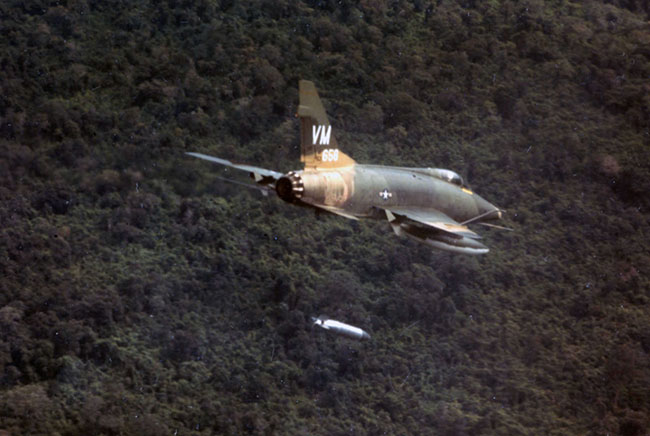An F-100D of the 352nd Tactical Fighter Squadron is shown dropping a napalm bomb near Bien Hoa, South Vietnam. Super Sabres could carry an impressive array of weapons, including high explosive bombs, napalm, rockets, cluster bombs and even the guided Bullpup missile. Air Force photo.
There will be more USAF fighter programs in the coming years, but each will yield fewer airplanes as the service moves toward a new “Century Series” of rapid turnover projects, Air Combat Command chief Gen. Mike Holmes said in an interview.
The new “Century Series” idea, championed by Air Force acquisition chief Will Roper, means “you’ll see fewer 1,500-aircraft programs” in the future because in the time it takes to develop and start fielding these new fleets, technology will have moved on and something better will have to be adopted, Holmes said.
“You’ll see programs that deliver a better capability now, and then every couple of years, revisit, and say, can we make that better?” he said. Some of the adjustments will be upgrades “we blend in” to an in-production fighter, but if a new platform is ready, then “let’s stop producing what we were, and start producing these instead.” The idea, Holmes said, is “you have multiple things in development and you see which ones are a little bit better and you shift your investments” into those. “And, you evaluate that routinely, instead of every 20 years,” he added. He did not say whether the new projects might lead to curtailing production of the F-35, of which the Air Force maintains it needs 1,763 aircraft.
The “Century Series” was the string of second generation fighters in the 1950s and 1960s with designations F-100 through F-111, which were rapidly developed and fielded, but were not expected to serve more than seven to 10 years before they were withdrawn from frontline service and supplanted by third- and fourth-generation types.
The budget request for the Next-Generation Air Dominance program in fiscal 2020 is more than $1 billion, and Holmes said the “Century Series” idea would be “part of how you’re going to maintain an air advantage. That can’t be static.” The NGAD line items says the money would be used for studies, prototyping, and experimentation.
Previous ACC commanders have discussed a “Penetrating Counter-Air” platform that might supplement or succeed the F-22 and F-35, but Holmes said the PCA is merely “one part” of NGAD, which aims for “a family of systems to be able to control the air and space like we pursue a family of systems to hold targets at risk in contested airspace. And it’s too early to say what’s going to show up.”
Roper, in a speech to AFA’s Mitchell Institute last week, said the savings resulting from his attack on sustainment costs can be used to pay for prototyping efforts, and the new aircraft themselves can be cheaper to obtain and sustain because they won’t be expected last 30 years or more.
The Century Series approach “gives you some options on the cost-effective side, if you know you’re not building an airplane to last 20,000 hours,” Holmes observed. “You can build it in a different way.”
The Air Force has been developing the Eagle Passive Active Warning Survivability System (EPAWSS) for over a decade—an eternity in the realm of electronic warfare—but Holmes said he believes it’s still relevant.
The reason for the long gestation, Holmes explained, is “like most complex programs, some of the issue is our ability to meet those requirements, some of the issues are the consistency of funding and maintaining the pace of funding.”
While EPAWSS “won’t make an F-15 into an F-35 or F-22, … it makes it a whole lot better and it expands the envelope where it can operate quite a bit … so yeah, I’m in favor of continuing the investment in EPAWSS.” He acknowledged, though, that at a time when the Air Force is struggling to field all the fighter squadrons it needs to carry out the National Defense Strategy, EPAWSS will actually subtract some fighters from the force due to the installation time.
“It’s one more thing that will put pressure on aircraft availability because we’ll have to pull airplanes out of use to go through the modification for EPAWSS,” he said, “but we have a plan to do it and we’ll manage it.”
Holmes also said the Air Force plans to continue buying MQ-9 Reapers for a while, both to replace combat losses and to “keep that fleet healthy,” but there’s a clear need for a more survivable platform, and efforts are being made in that direction.
“In the press you’ve seen, this spring, discussion of a couple of … ‘loyal wingman’ projects,” Holmes noted, such as one Australia is pursuing with Boeing, and an Air Force Research Labs project with Kratos called Valkyrie.
“So I think we’re investing in the R&D and experimentation to see what comes next while we maintain that persistent attack and reconnaissance capability the COCOMs (combatant commanders) depend on, with the MQ-9.”
A senior defense official recently told Pentagon reporters the Air Force is “absolutely” pursuing Arsenal Plane ideas, and Holmes said this is happening on several fronts.
“We’re pursuing both penetrating capabilities in the B-21 and the family of systems that support that, and the new family of standoff capabilities” in the area of hypersonics and standoff missiles, Holmes reported. The air-launched hypersonics weapons “have to be air-launched by something,” the B-52s are slated to be “around a long time, and it’s a great platform” for such munitions, Holmes noted. Especially if the B-52 re-engining initiative works out, “I think you’d expect it to be used as standoff weapons platform, and a great one.”
He added, “Certainly, the F-15 has some capacity to do that, too.”
